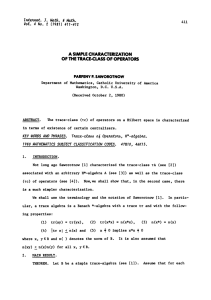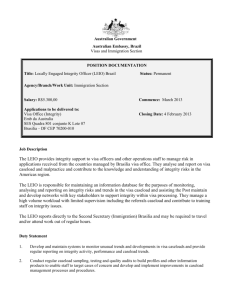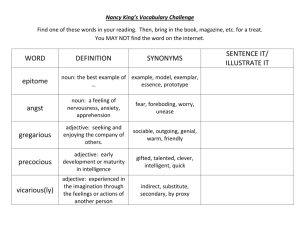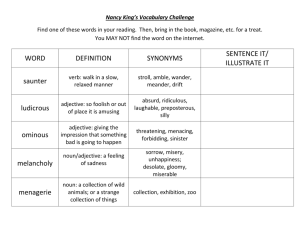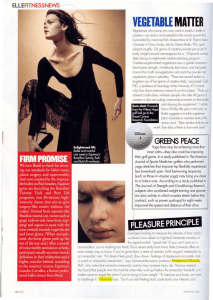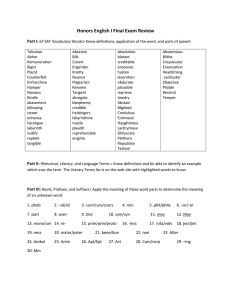P M 2 0 8 R
advertisement
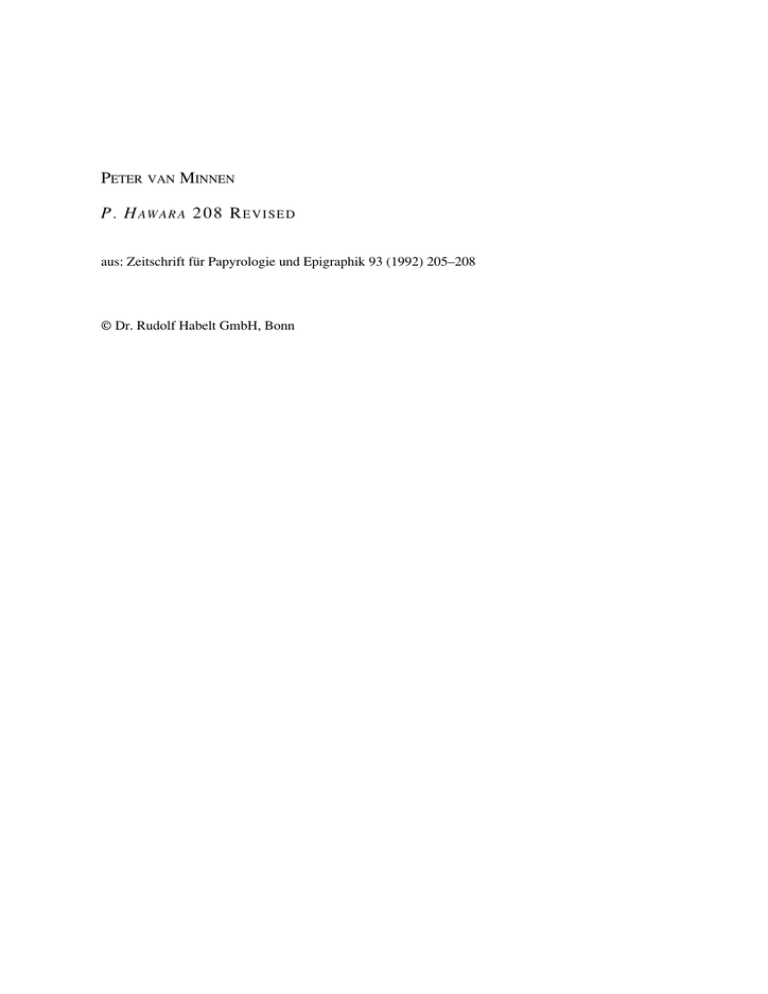
PETER VAN MINNEN P. H A WA R A 208 R E VI SE D aus: Zeitschrift für Papyrologie und Epigraphik 93 (1992) 205–208 © Dr. Rudolf Habelt GmbH, Bonn 205 P. Hawara 208 Revised1 A few years ago I discussed P. Hawara 2082 in a note on P. Oxy.Hels. 40 and the implications that papyrus might have for our view on the volume of the Oxyrhynchite textile trade. 3 P. Oxy.Hels. 40 registers payments for customs duties, and I suspected that P. Hawara 208 would do the same. The main reason for this was provided by the curious entries in lines 2 and 6 of the Hawara papyrus: ÉAr[!inoeit]ik«n xiy(«no!) a∑ t`e[ and ÉAr!inoeitik«n xiy(«no!) a∑ g`e[ It should be xiy(≈nvn) in both cases, as had already been suggested by the editors of C. Pap.Iud. But what about the two instances of a ∑? Two misreadings seemed excluded. Therefore I suspected the a∑ and the b∑ in P. Hawara 208 served the same purpose as they do in P. Oxy.Hels. 40. There they are used to distinguish various types of clothes mentioned in the list. The various types are taxed at different rates. In the meantime, however, I have had the chance of checking Milne's transcription on a photo.4 In both lines the papyrus turns out to read xiy(≈nvn) d∑. Closer inspection of the photo reveals that my suspicion that the papyrus is a register of customs duties, or perhaps a private extract from such a register, is correct. In lines 5 and 11 the papyrus definitively refers to the r ka‹ n tax, the ordinary customs duties of 1% and 2% in the Arsinoite nome.5 P. Hawara 208 antedates the earliest attestation of the r ka‹ n tax we had thus far by 19 years (see P. Customs 4 of A.D. 43/44). A new transcription of col. II of the front side6 of P. Hawara 208 may not be unwelcome. The first column shows the end of five lines. After some illegible traces the first line ends in (d`r`a`x`m`å`!`) É A!p. The other lines end in (d`r`a`x`m`å`!`) É Aup, (d`r`a`x`m`å`!`) ne, (d`r`a`x`m`å`!`) !`ke` ` (very uncertain) and (draxmå!) r`e. 1 This article owes much to a discussion with Professor R.S. Bagnall. P. Hawara 208 was first published by A.H. Sayce in W.M.F. Petrie, Hawara, Biahmu and Arsinoe (London 1889), 30, and republished by J.G. Milne, APF 5 (1913), 388-389. It was reprinted after Milne in C.Pap.Iud. II 415 as "a list of clothes". 3 In Münstersche Beiträge zur Antiken Handelsgeschichte 5.2 (1986), 88-95. 4 Through the kind offices of Dr. W.E.H. Cockle. On the photo (pl. **) the left portion of the papyrus is a few millimeters too low in regard to the right portion. 5 On customs duties see now P.J. Sijpesteijn, Customs Duties in Graeco-Roman Egypt (Zutphen 1987). Sijpesteijn mentions P. Oxy.Hels. 40 on p. 86 in his discussion on the customs house registers (pp. 85-90), but not P. Hawara 208. 6 The back side shows the remains of a column of 13 lines, much less carefully written than the text on the recto, but probably in the same hand. The upper and lower margins are preserved. It appears to be an account in drachmas and obols. The first line reads prç!`i! and is preceded by a check mark as are some of the other lines. To the left the ends of at least four lines of a preceding column are visible. To the right there is a blot of ink caused by the scribe when he tried out his pen. 2 206 P. van Minnen Arsinoite nome 10.9 x 13.2 x cm. A.D. 24/25 Col. II → [¶]tou! ia Tiber¤ou Ka¤!a[ro! (month, day) ] ∑ ka‹ ∑n ÉAr!`i`n`o`e`i`t`ik«n xiy(≈nvn) d∑ tel`[e¤vn r ] ÉA!klhpiãdh! [ ] ∑ [ka‹ ∑n 4 ÉAr!inoeitikoË xiy(«no!) a∑ tel(e¤ou) r` ] ∑ k[a‹ ∑n ÉAr!inoeitikoË imi!( ) a∑ r ] ∑ ka‹ ∑n ÉAr!inoeitik«n xiy(≈nvn) d∑ tel(e¤vn) [r ] ∑ ∑ ÉAr!inoe`i`t`[ik«n] xiy(≈nvn) b[∑] t[el(e¤vn) r ka‹ n ] 8 ÉA`m`[m]≈nio! [ ] ∑ ka‹ ∑n id ÉAr!inoei[ti]k`[oË xiy(«no!)] a∑ par`a`(tele¤ou) [r ] ∑ ka‹ ∑n ÉAr!inoeitikoË imi!`( ) a∑ ÉAnoub(iakoË) [r ] ÉAr!inoeitik«n xiy(≈nvn) bÄ para(tele¤vn) rÄ k[a‹ nÄ ] ∑ ka‹ ∑n 12 ÉAr![inoei]tikoË xiy(«no!) a∑ para(tele¤ou) [r ] Y[eodÒ!]io! ÉIouda›ou diå t[ ] [ÉA!klh]piãdou toË ÑAr!i!`[oÊxou] ∑ ka‹ ∑n [ÉAr!ino]e`itikoË xiy(«no!) a∑ p`[ar]a`(tele¤ou) [r ] 16 ÉAmm≈no[! — — — — — — — — — — — — — — — — — — — _________ all abbreviations are indicated by putting the last letter on top of the preceding (see note) 16 read ÉAmm≈nio! (see note) 13 read ÉIouda›o! In the 11th year of Tiberius Caesar [(month day)]. For 4 full-sized Arsinoite tunics, [for the 1% and 2% tax, (amount of money)]. Asclepiades [ – – – ]. For 1 full-sized Arsinoite tunic, for the 1% and 2% tax, [(amount of money)]. For 1 Arsinoite (h)imis( ), for the 1% and 2% tax, [(amount of money)]. For 4 full-sized Arsinoite tunics, [for the 1% and 2% tax, (amount of money)]. For 2 full-sized Arsinoite tunics, [for the 1% and 2% tax, (amount of money)]. Ammonius [ – – – ]. For 1 nearly full-sized Arsinoite tunic, [for the 1% and 2% tax, (amount of money)]. For 1 Arsinoite (h)imis( ) in the fashion of Anoubis, [for the 1% and 2% tax, (amount of money)]. For 2 nearly full-sized Arsinoite tunics, for the 1% and 2% tax, [(amount of money)]. For 1 nearly full-sized Arsinoite tunic, [for the 1% and 2% tax, (amount of money)]. Theodosius the Jew through the intermediary of [ – – – ] Asclepiades, son of Harsisouchos. For 1 nearly full-sized Arsinoite tunic, [for the 1% and 2% tax, (amount of money)]. Ammonius [ – – – ]. 1: to judge from lines 13-14, the average length of the lines was ca. 30-35 letters. In the lacuna in this line all we need is the name of a month and a date. 2: again, if the average length of the lines was ca. 30-35 letters, there is room in this line and in most of ∑ ka‹ ∑n and the amount of money paid for it. the others only for the name of the tax, presumably r P. Hawara 208 Revised 207 ÉAr!`i`n`o`e`i`t`ik«n xiy(≈nvn): tunics from Arsinoe. This type of textile is mentioned in the Periplus Maris Erythraei 6 (ÉAr!inoitika‹ !tola¤) and 8 (!ãgoi ÉAr!inoitiko‹ gegnamm°noi ka‹ bebamm°noi). The tunics here are called after the town where they were produced or where they were traded. In the latter case they do not really need to have been produced in Arsinoe itself. See my remarks on Vergilius, Georgica I 228 in Mnemosyne IV 44 (1991), 167-170. At least the passages on the two types of Arsinoite cloaks in the Periplus show that this particular kind of Egyptian textile was part and parcel of what can be referred to as international trade in the early Roman period. tel`[e¤vn: if correctly restored, the word would not have been abbreviated to tel(e¤vn), as we would expect from the rest of the text. There is no trace of a lambda above the epsilon. I have translated t°leio! as "fullsized", largely because in P. Oxy.Hels. 40 t°leio! stands in opposition to paidikÒ!.7 Properly speaking t°leio! means "for adults". See my remarks on P. Oxy.Hels. 40 (above n. 3). Further on in our text the rare adjective parat°leio! ("near-t°leio!") suggests that the ancients themselves treated t°leio! very much like an adjective denoting size. See the note on line 9. 3: this looks like the heading of the four lines that follow. It should, however, refer to the immediately preceding line, because that line lacks a heading. Similarly, in the first entry for the taxes collected on the 14th of the month (lines 9ff.), four payments are registered (lines 9-12) before the name of the tax-payer is mentioned (lines 13-14). Hence, lines 3, 8, 13-14 and 16 all refer back. Asclepiades, Ammonius, and Theodosius are presumably the traders dealing in textiles. The amounts they carry (perhaps literally) are not large. In the lacuna there is enough room for, e.g., a patronymic. We may have to supply the one given in line 14, [ÑAr!i!oÊxou], if it concerns the same Asclepiades there. 5 imi!( ): Milne interpreted this as flm(at)i!(moË), but that seems a very unlikely abbreviation. The word flmati!mÒ!, moreover, is not specific enough. One might interpret imi- as ≤mi- and try ≤mi!(tol∞!) or ≤mi!(ãgou), in view of the passages in the Periplus referred to above. But half a cloak or dress is useless and would hardly be counted as one piece. The word imi!( ) could be Egyptian; cf. Pollux' derivation of ≤mitÊbion from the Egyptian (VII 71). Note that no adjective denoting size is given for this particular type of textile (see line 10 for imi!( ) in combination with another adjective). 9 par`a`(tele¤ou): if correctly read this adjective again refers to the size of the tunic (see note on line 2). It is impossible to read paid(ikoË) here or elsewhere in this text, as I had suggested in the article on P. Oxy.Hels. 40 referred to above. Prof. R.S. Bagnall informed me that the adjective parat°leio! occurs in a fourth-century codex in the papyrus collection at Columbia University.8 It refers to military clothing in that text. This supports taking the very terse abbreviation para( ), occurring after t°leio! as it does here, as para(t°leio!) rather than deriving it from parã(phxu!), a suggestion made by the editors of C.Pap.Iud. The adjective parat°leio! is very rare. According to the original editor of SB XIV 11432 it also oc-curs in line 5 of that text. It concerns the sale of a mÒ!xon paratelh`n (read paratel∞ or parat°leion). The passage shows that an adjective like parat°leio! can be used for an animal that is nearly full-grown, like a calf. In relation to clothing the adjective parat°leio! can be interpreted in two ways. Because t°leio! refers to adults in the parallel texts dealing with clothing (see the note on line 2), parat°leio! can be either "for near-adults" or "nearly adult-sized" (i.e. "nearly full-sized)". I prefer the second alternative, because it is difficult to suppose that special clothing for teenagers existed in Graeco-Roman Egypt. But the net result of both lines of interpretation is the same: parat°leio! refers to clothing that is slightly smaller than that normally woven for adults. Prof. R.S. Bagnall points out that the abbreviation p( ) in P. Oxy.Hels. 40 might stand for p(arat°leio!) rather than p(aidikÒ!), which is otherwise abbreviated paid(ikÒ!) in that text. That would prove that both t°leio! and parat°leio! refer to size. 7 As it does in P. Hamb. I 10, 13-16. See the editor's introduction as against Preisigke, Wörterbuch s.v. t°leio!, 1. 8 See now J.A. Sheridan, Roman Military Clothing Requisitions (diss. Columbia 1990), especially pp. 83-87. 208 P. van Minnen 10 ÉAnoub(iakoË): it is difficult to see why a special type of clothing "in the fashion of Anoubis" existed in Graeco-Roman Egypt. An ÉAnoubiakØ !tolÆ is mentioned in P. Giss.Univ.-Bibl. I 10 II 14-15 (from the later Ptolemaic period). The editor glosses "Kleid eines Priesters des Anubis", but it seems to me that ÉAnoubiakÒ! in relation to textiles rather refers to some specific kind of material. This is suggested by PGM I 147148, where a !pãrton ÉAnoubiakÒn occurs; IV 1083, where linãria ÉAnoubiakã are mentioned; and XXXVI 237, where a l¤non ÉAnoubiakÒn is found. See also PGM IV 2899-2900. Of course, in the magical papyri ÉAnoubiakÒ! denotes the kind of linen magicians would use. Ordinary clothes could also have been made of this special kind of linen, as is shown by P. Giss.Univ.-Bibl. I 10 and the present papyrus. 13 Y[eodÒ!]io!: if correctly supplemented, the name by itself would already suggest that we are dealing with a man of Jewish extraction. See the prosopographical index in C.Pap.Iud. III. The name is followed by ÉIouda›ou, which I take to be a slip for ÉIouda›o!. ÉIouda›o! is not attested as a proper name,9 and "the son of a Jew" seems difficult. 14 ÑAr!i!`[oÊxou]: difficult, but it is at least an attested name. The two papyri in which it occurs, P. Lond. III 1170 and P. Mich. II 126, are both from the Arsinoite nome. Asclepiades may be the same trader as the one mentioned in line 3, now acting as an intermediary for a colleague. But it could also be another person, identified by a double name as well as by his father's name. 16: if the trader in this line is the same as the one in line 9, ÉAmm≈no! must be a slip for ÉAmm≈nio!. A name starting with ÉAmmvno- (like ÉAmmvnoy°vn) is, however, not excluded. Ann Arbor 9 rule. Peter van Minnen Plutarchus, De Iside et Osiride 31, a reference to a mythical ÉIouda›o!,, is the exception that proves the TAFEL XII Verzeichnis von Zolleinnahmen (P.Hawara 208)
